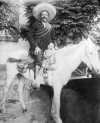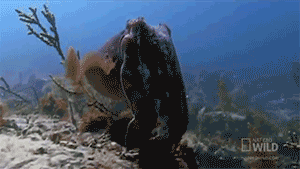This day is an annual celebration of Life. This is to raise awareness of Cancer Survivors – In the U.S. alone there are over 11 million survivors, and to raise funds for Cancer Research Charities.

Word of the Day
| |||
| Definition: | (noun) A physical alteration thought to occur in living neural tissue in response to stimuli, posited as an explanation for memory. | ||
| Synonyms: | memory trace | ||
| Usage: | The neuroscientist likened engrams in neural tissue to data on the hard drive of a computer. | ||
thanks, heide

Idiom of the Day
above the salt— Of or in a position of high standing, rank, regard, or repute. The term is derived from the social hierarchy of nobility in medieval times, in which salt, a precious commodity then, was set in the middle of the dining table. Those of high noble rank were seated "above the salt," that is, closer to the lord and lady of the house, while those in lower social standing were seated "below" it. |

History
| |||
 | Villa was a legendary Mexican guerrilla leader. He fought for land reform and joined with revolutionaries against dictator Porfirio Díaz as well as his successor but was forced to flee after breaking ties with Venustiano Carranza, who had assumed power in 1914. Angered by US support for Carranza, Villa raided a New Mexico town in 1916. A US force was sent to apprehend him, but he managed to evade capture. Three years after he was finally pardoned, he was assassinated. | ||
| |||
 | The United Nations General Assembly designated June 5 as World Environment Day in 1972. The date was chosen because it marked the opening day of the United Nations Conference on the Human Environment, which led to the establishment of the United Nations Environment Programme. The General Assembly urges countries and organizations to mark this day with activities that educate people about threats to the environment and encourage them to strike a balance between development and concern for Earth's future | ||
| |||
| The story of the black peppered moth, which changed colors from Oreo milkshake to dark chocolate during the Industrial Revolution in Britain, is the iconic tale of adaptive evolution taught in science classes. | |||
1752 - Benjamin Franklin flew a kite for the first time to demonstrate that lightning was a form of electricity.
1851 - Harriet Beecher Stowe published the first installment of "Uncle Tom's Cabin" in "The National Era."
1927 - Johnny Weissmuller set two world records in swimming events. Weissmuller set marks in the 100-yard, and 200-yard, free-style swimming competition.
1964 - David Jones and The King Bees had their first record, "Liza Jane", released. David Jones later became known as David Bowie.
1971 - James Taylor's "You've Got A Friend" was released.
1981 - In the U.S., the Center for Disease Control and Prevention reported that five men in Los Angeles were suffering from a rare pneumonia found in patients with weakened immune systems. They were the first recognized cases of what later became known as AIDS.
2004 - The U.S.S. Jimmy Carter was christened in the U.S. Navy in Groton, CT.

DAILY SQU-EEK

thanks, shelley

| Picture of the day | |
 |
The Panorpidae are a family of scorpion flies. This family contains more than 350 species. These insects, which average 9–25 mm long, have four membranous wings and threadlike antennae. Their elongated faces terminate with jaws that are used to feed on dead and dying insects, nectar, and rotting fruit. While in larval form, they scavenge by consuming dead insects on the ground.
Pictured here is a Panorpa alpina male.
|

The Fabric of Life
Photograph by Toni Wallachy, National Geographic
“[This photo has] all the makings of a perfect artist’s palette,” writes Toni Wallachy about her image of Havana, Cuba. “Decrepit architecture, the essence of what a war-torn city might look like; a cloudy haze of pollution, where dust, smoke, and other dry particles obscure the clarity of the skyline; muted, sun-aged walls; [and] a time warp of artifacts that make up the daily fabric of life.”

knit

crochet, FATHER'S DAY
crochet
crochet
crochet
crochet


RECIPE
Buffalo Chicken Dip + PEPCID® COMPLETE® - The C...
Yummy Buffalo Chicken Dip Recipe
| |||||||

CROCKPOT RECIPE
Asian Style Country Ribs


SWEETS

CRAFTS, FATHER'S DAY

thanks, helen

CHILDREN'S CORNER ... FATHER'S DAY

PUZZLE

QUOTE




CLEVER

EYE OPENER
The Root of the Word Afghan crochetconcupiscence
Laurie Balbo wrote an article for Green Prophet about Afghans for Afghans, a charity crochet project that accepts knit and crochet blankets for people in the Middle East. In her article, she muses upon why afghans are called afghans and through research finds out that indeed it is because of the people of Afghanistan.
First Balbo explains that the word itself dates back to the eighteenth century when it was first used to refer to the people living in a specific area of Afghanistan. She goes on to explain:
“That country is known for its distinctive textiles, colorful carpets and lustrous karakul wool, so it’s sort of logical that “afghan” was picked up to refer to knitted or crocheted blankets. The word went mainstream in America in the early 1800′s, describing blankets and shawls made from multi-hued yarn.”
She notes that the colorful style of the granny square blanket especially resembled “a particular type of colorful Colonial-era rug brought over from England, by way of the Middle East” and could be a link to why the granny square blanket is often called an afghan. Possibly – it’s just one theory.
And What About The Granny Square?
In passing Balbo also mentions that the scrap yarn blankets that people were crocheting, especially popular in the middle of the twentieth century, were named “granny squares” because it was common for “granny” to be the person making these. I don’t know if that’s true. It sounds a little fishy to me in a way, one of those things that buys too much into the stereotypes of crochet. But it could be true. What do you think?
Three types of patterns which use granny squares differently:






















No comments:
Post a Comment